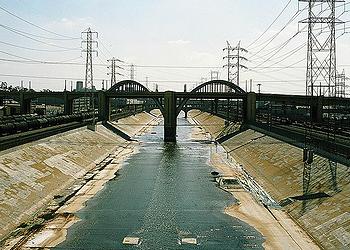
WASHINGTON, DC, January 9, 2013 (ENS) – The U.S. Supreme Court has ruled that the Los Angeles County’s Flood Control District can side-step responsibility for the high levels of polluted stormwater found in the Los Angeles and San Gabriel Rivers, but only temporarily.
In a lawsuit initiated in 2008 by the Natural Resources Defense Council and Santa Monica Baykeeper (now Los Angeles Waterkeeper), the groups sought to hold the county responsible for the mix of mercury, arsenic, cyanide, lead and fecal bacteria found in billions of gallons of stormwater that runs from concrete-lined stretches of the two rivers into lower, unlined portions of the same rivers.
The Supreme Court addressed the narrow question – does the flow of water out of a concrete channel within a river rank as a “discharge of a pollutant” under the Clean Water Act?

Before the Supreme Court, all the parties as well as the government of the United States agreed that the answer to this question is “no.”
The opinion issued by the Supreme Court reversed an earlier ruling by the Ninth Circuit Court of Appeals.
But the Supreme Court opinion did not deal with the larger issue of polluted stormwater flowing down the two rivers and into the Pacific Ocean. It did not excuse Los Angeles County from liability for ongoing water pollution in the Los Angeles and San Gabriel Rivers, nor did it find the District liable for the pollution.
Instead, the case was sent back to the Federal District Court level for decision on the central issue of whether under the terms of the District’s federal stormwater discharge permit, the pollution exceedances found at the instream monitoring stations are sufficient to establish the District’s liability under the Clean Water Act for its upstream discharges.
“We’ll continue to seek to hold the Los Angeles County Flood Control District responsible for cleaning up its water pollution,” said Steve Fleischli, senior attorney and director of NRDC’s national water program.
“Unless something changes, stormwater pollution will continue to sicken up to one million people in Southern California every year, while local government turns a blind eye and avoids basic infrastructure solutions that will protect people, preserve water quality and increase water reserves,” Fleischli said.
“The county has managed to game the system in a way that has allowed the pollution of our waterways to go unaddressed for many years,” said Liz Crosson, executive director of Los Angeles Waterkeeper. “The county is the largest source of stormwater pollution to local waterways, and today it has escaped accountability, but only temporarily.”
Gail Farber, chief engineer of the District and director of the County of Los Angeles Department of Public Works, said, “Our work is not done. The fight for clean water is ongoing and remains a collective priority for the District and our many water quality stakeholders within the region.”
“The District remains committed to working with our partners in support of clean water, healthy rivers, lakes and beaches,” Farber said.
Stormwater pollution is created when rain mixes with debris, chemicals, dirt, and other pollutants and flows into a storm sewer system or directly to local waterways. Anything that enters a storm sewer system is discharged, largely untreated, into waterbodies used for swimming, fishing and recreation.
Each year, billions of gallons of this untreated stormwater pollution are discharged into Los Angeles rivers and flow onto popular beaches, causing residents and tourists to become ill.
The environmental groups point out that this pollution can be prevented through the development of green infrastructure solutions, such as on-site water capture and filtration.
These techniques trap stormwater pollution at the source, rather than allow it to flow to sea untreated, and allow rainwater to be reused rather than wasted.
“Green infrastructure is not only good for public health and smart environmental policy, it will save money, increase water supplies, reduce flood risks and clean up local beaches and rivers,” the environmental groups said in a statement Tuesday. “The county has not used these available techniques as effectively as it should.”
“The county owes it to residents and visitors alike to step up and control this pollution by utilizing the range of green infrastructure solutions that are available today,” said Fleischli. “Now more than ever it will be important for the county, local residents, and the Los Angeles Regional Water Quality Control Board to ensure this enormous problem is addressed.”
Copyright Environment News Service (ENS) 2013. All rights reserved.
